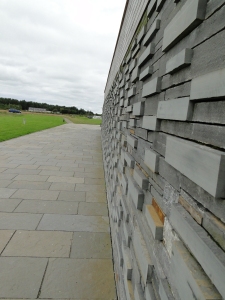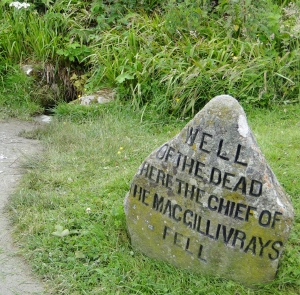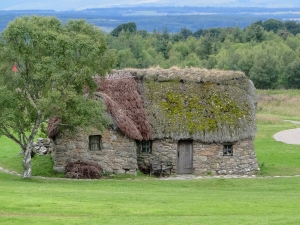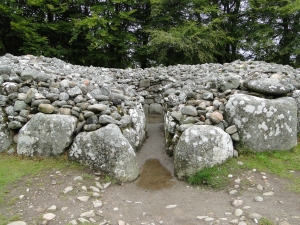Sept 9 -Where Was the Last Battle in Britain?
Culloden
is a solemn site to walk around in. Below is a panorama of the site of the battlefield.
 |
| The flag on the left side indicates the Jacobite lines, the flag on the right side shows the location of the Government lines |
Not only is it the site of
the last full-scale battle to take place on British soil, and the
last stand of an ancient royal dynasty which traced its ancestry
back to the Dark Age Gaelic Kingdom of Dal Riata and beyond, but
it is also the place where the Highland clan culture of Scotland
sang its last song.
 |
| Beautiful clear blue sky looking down on what must have been a terrible sight - over 250 years ago |
The Battle of Culloden in 1746 meant, quite
simply, the end of an era for Scotland. It took place near Inverness in the Scottish Highlands.
Between 1,500 and 2,000 Jacobites were killed or wounded in the brief
battle, while government losses were lighter with 50 dead and 259
wounded.
 |
| Each brick is a Scottish lad that died |
Outside the visitor's center, the wall has a brick that stands proud for each Highlander that fell.
Inside the visitors center, the visitor gets the perspective of the
British on the left side of the exibit, and the Highlanders on the
right, and follows the developments leading up to the fateful battle
that occurred on April 16, 1746. At the end of the walk through there is
a 360 degree theater where film plays with a re-enactment of the battle
with the Scottish Highlanders stretched out roughly halfway around and
the British opposing, with the visitors standing in between to
understand the perspective. The battle itself lasted less than an hour,
but within the first three minutes, 700 Highlanders lay dead on the
cold, wet moore, while the English army lost only 50, with 259 wounded.
There were monument stones for MANY Scottish clans and I'll have to say that most of the names I knew someone and had to ponder the fact that possibly they are related to those who so bravely fought for their country and their ideals and their traditions.
 |
| Stewart Clan |
Others were MacEachen, Kennedy, Campbell, and many others.
 |
| "The English were buried here." |

The
Well of the Dead is
one of the most famous markers on the field among the clan grave
stones. It marks the place where Alexander MacGillivray fell in battle,
and also one of the sites of heaviest casualties.
 |
| A couple of stones with faded writing - more clan names more than likely. |
The Duke of Cumberland, wanting to make sure such a rebellion never
happened again, sent troops all through Scotland to burn the cottages
and dwellings, frequently shooting Highlanders regardless of (and
sometimes not even asking) their sympathies, and turning women and
children out of their homes to starve. He was nicknamed
"The Butcher."
The only surviving building after
the battle was the
Old Leanach Cottage which was inhabited until 1912
and then kept preserved by the Gaelic Society of Inverness. Old Leanach
Cottage
is now kept by the National Trust for Scotland, as is the Moor, and
the Old Leanach Cottage has been refurbished to look
like it would have done in the 18th century. The cottage did have
surrounding barns but these were burnt down when Government redcoats
found 30 wounded
Jacobites seeking refuge within them. So they barricaded the barn and
burnt the Jacobites alive.
 |
| The cottage is made of stone, but has dirt floors and a roof of
heather. |
The building was used as a field-hospital after the battle for government troops.
 |
| Another view of the Old Leanach Cottage with its thatched roof. |
We took this photo, but I found the first one interesting for the "live" heather and grass on the roof.
Ghosts at Culloden Moor
There are said to be many ghosts at Culloden Moor such as anniversary
ghosts who return on the 16th of April to relive the battle and their deaths.
These Culloden ghosts
make themselves heard by the cries of battle. Some witnesses have heard
the clash of steel on steel as if of broadsword and sword fighting.
One legend of Culloden Moor is that birds do not sing at the exact
site of the battle or at the graves of the slaughtered Jacobites. Other
local legends at
Culloden Moor is that heather which grows nearby will never grow over
the graves of the Jacobites.
Which one of these photos has a huge honey bee scouring for some pollen? We really enjoyed the beautiful heather throughout the battlesite...such a positive site as we learned of the horrific battle.
The Thistle has been the national emblem of Scotland since the reign of
Alexander III in the 13th century, and it also grows wild on Culloden. Interesting with its terrible prickles, but the purple flower is one of the prettiest of all wildflowers.
 A prehistoric cemetery
A prehistoric cemetery
We decided we had some time before the last bus back to Inverness, so we walked to the Clava Cairns, about 3 miles one way. It was a sweet walk, with wild berries to munch on the way. We didn't even know what we were about to see, but Graeme had mentioned it would be worth it.
 |
| Railroad Bridge above the river - on the way to the Cairns |
On a gravel terrace above the River Nairn is one of Scotland’s
finest prehistoric monuments in the Highlands. The Clava Cairns are dominated by a
line of three well-preserved burial cairns, each enclosed
by stone circles. Located in the beautiful wooded highlands, we know little about who the cairn builders were, for
they left no written record. The cairns date back almost 4000 years (Bronze age)
and are still remarkably well intact considering their age. The actual remains of those buried within
the cairns no longer survive because of overzealous archaeological
digging in the early 20th century. However, recent excavations have shed
new light on the cairns.
There are three separate cairns here, two for holding the souls of the dead until they continue on their way in the afterlife,

and one for cremating the bodies. They also served as a giant sundial
and calendar for the people who lived here so long ago. If you visit
during the December Solstice, you can see the sun stream through the
opening at sunset.
The site is made up of passage graves, ring cairns and also a kerb
cairn, each of which are surrounded by a ring of impressive standing
stones. There are also the remains of what seems to have been a chapel
of some description, although a date for that is unknown.
 |
| A Kerb Cairn |
Such a stillness and serenity as we went from formation to formation. Very few people came through while we were there, so I really tried to imagine these sacred people from so long ago and all their customs - it was quite an amazing feeling! We quickly ate our sack lunch while enjoying the peaceful setting.
The three well-preserved cairns each have a central chamber. But while
the two outer cairns have entrance passages, the chamber of the central
one is completely enclosed. The outer kerb of each cairn is well defined
by large boulders, and each is surrounded by a ring of standing stones.
 |
| Trying to commune with the dead in this most unusual cemetery. |
 |
| How did they roll these rocks into place and place them up? |
 |
| This Scottish guide came into the area with a small group of tourists. |
These stone cairns were later thought to be
used for Pagan worship and other ritual rites. Just seeing the stone
circles, surrounding the several feet high (and huge circumference)
cairns, stacked high with stones...makes you really think. The grounds
feel mystical and magical, in their own way. If you are a Diana Gabaldon
("Outlander" series) fan, then you will be psyched to see the split
rock in the standing stones that inspired Gabaldon for Claire's journey
back in time.

These people were Sun Worshippers!
The three cairns form a line running NE to SW. The passages of the two
cairns are also similarly aligned, suggesting that the builders had
their eyes on the midwinter sunset. The standing stones around the cairns also acknowledge
the midwinter sunset, for they are graded in height – the tallest facing
the setting sun in the SW down to the lowest on the opposite side. Even
the color and texture of the stones seems to have been carefully
selected to emphasize the veneration of the sunset on the shortest day
of the year.
Bus Back to Inverness
We had to hike FAST to make it back to catch the last bus.
 |
| Along the way we saw a nursing mother cow (with horns!!??) |
 |
| So many Scottish women color their hair to this wild red color. |
 |
| Love those kilts and the "Highland Fling" |

The main shopping area of Inverness is situated on the east bank of the
River Ness and is located roughly between the two car parks, the railway
station, Friars Bridge and Cathedral. Another area is a covered shopping centre- the
Victorian Market which is far more interesting and goes back a long time. The first
covered market in Inverness was built in 1876-70 but it was destroyed by
fire, although the original sandstone entrance in Academy Street
remains. Following the fire the Victorian Market was rebuilt in 1890-91.
 |
| Victorian Market - downtown Inverness |
 |
| "You want me to wear that? Not on your life!" |
 |
| When it started raining, we escaped to an inside mall with lots of shops. |
 |
| Scottish Plaids, luck of the green, and of course, Nessie |
When the rain let up, we walked around the city and saw the main highlights.
Inverness Castle sits on a cliff overlooking the River Ness. The red sandstone structure evident today was built in 1836 by architect William Burn. It is built on the site of an 11th-century defensive structure. Today, it houses Inverness Sheriff Court. There has been a castle at this site for many centuries.
 |
| Inverness Castle |
 |
| River Ness, Ness Bridge and Inverness Castle |
 |
| I took this photo with the pretty flowers - whoo hoo! |
 |
| There were wild rabbits EVERYWHERE on the hillside below the castle. |
 |
| Faith, Charity, and Love Monument |
 |
| "I love watching all the silly people below and the funny things they do." |
 |
| St. Andrew's Cathedral - built in 1866. |
What a great stay we had in Inverness and with our host, Graeme. Tomorrow we fly to Belfast, Ireland on a most beautiful flight....and to the "Titanic Museum."





 The Well of the Dead is
one of the most famous markers on the field among the clan grave
stones. It marks the place where Alexander MacGillivray fell in battle,
and also one of the sites of heaviest casualties.
The Well of the Dead is
one of the most famous markers on the field among the clan grave
stones. It marks the place where Alexander MacGillivray fell in battle,
and also one of the sites of heaviest casualties.




 and one for cremating the bodies. They also served as a giant sundial
and calendar for the people who lived here so long ago. If you visit
during the December Solstice, you can see the sun stream through the
opening at sunset.
and one for cremating the bodies. They also served as a giant sundial
and calendar for the people who lived here so long ago. If you visit
during the December Solstice, you can see the sun stream through the
opening at sunset.






 The main shopping area of Inverness is situated on the east bank of the
River Ness and is located roughly between the two car parks, the railway
station, Friars Bridge and Cathedral. Another area is a covered shopping centre- the Victorian Market which is far more interesting and goes back a long time. The first
covered market in Inverness was built in 1876-70 but it was destroyed by
fire, although the original sandstone entrance in Academy Street
remains. Following the fire the Victorian Market was rebuilt in 1890-91.
The main shopping area of Inverness is situated on the east bank of the
River Ness and is located roughly between the two car parks, the railway
station, Friars Bridge and Cathedral. Another area is a covered shopping centre- the Victorian Market which is far more interesting and goes back a long time. The first
covered market in Inverness was built in 1876-70 but it was destroyed by
fire, although the original sandstone entrance in Academy Street
remains. Following the fire the Victorian Market was rebuilt in 1890-91. 




























No comments:
Post a Comment